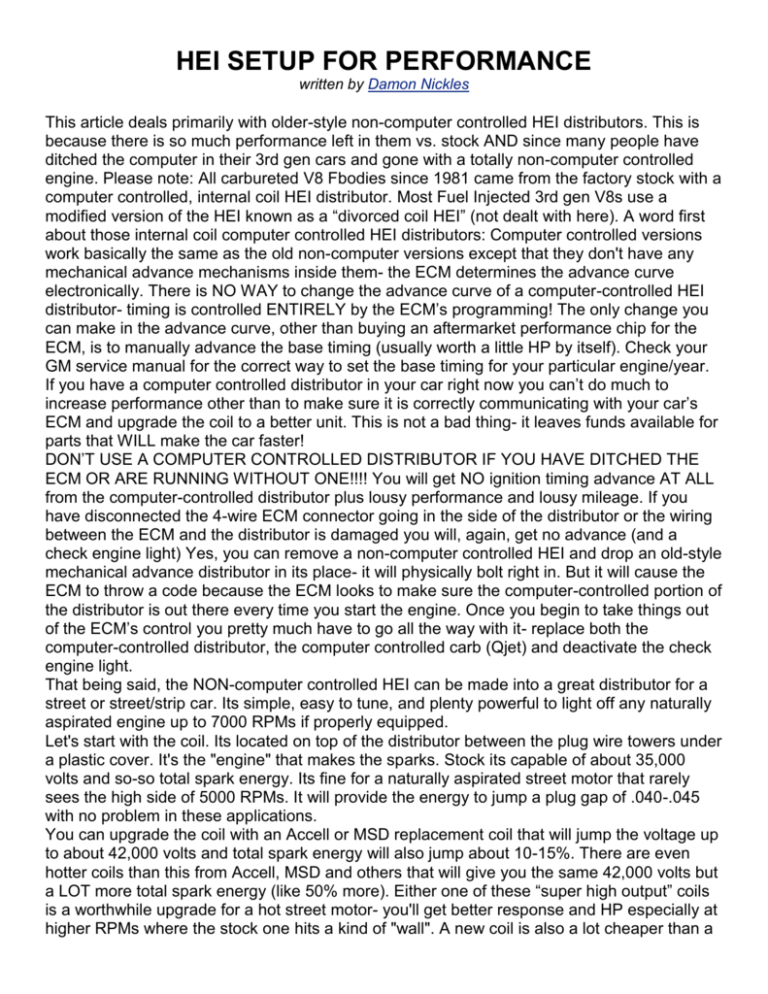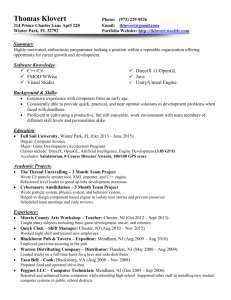
HEI SETUP FOR PERFORMANCE
written by Damon Nickles
This article deals primarily with older-style non-computer controlled HEI distributors. This is
because there is so much performance left in them vs. stock AND since many people have
ditched the computer in their 3rd gen cars and gone with a totally non-computer controlled
engine. Please note: All carbureted V8 Fbodies since 1981 came from the factory stock with a
computer controlled, internal coil HEI distributor. Most Fuel Injected 3rd gen V8s use a
modified version of the HEI known as a “divorced coil HEI” (not dealt with here). A word first
about those internal coil computer controlled HEI distributors: Computer controlled versions
work basically the same as the old non-computer versions except that they don't have any
mechanical advance mechanisms inside them- the ECM determines the advance curve
electronically. There is NO WAY to change the advance curve of a computer-controlled HEI
distributor- timing is controlled ENTIRELY by the ECM’s programming! The only change you
can make in the advance curve, other than buying an aftermarket performance chip for the
ECM, is to manually advance the base timing (usually worth a little HP by itself). Check your
GM service manual for the correct way to set the base timing for your particular engine/year.
If you have a computer controlled distributor in your car right now you can’t do much to
increase performance other than to make sure it is correctly communicating with your car’s
ECM and upgrade the coil to a better unit. This is not a bad thing- it leaves funds available for
parts that WILL make the car faster!
DON’T USE A COMPUTER CONTROLLED DISTRIBUTOR IF YOU HAVE DITCHED THE
ECM OR ARE RUNNING WITHOUT ONE!!!! You will get NO ignition timing advance AT ALL
from the computer-controlled distributor plus lousy performance and lousy mileage. If you
have disconnected the 4-wire ECM connector going in the side of the distributor or the wiring
between the ECM and the distributor is damaged you will, again, get no advance (and a
check engine light) Yes, you can remove a non-computer controlled HEI and drop an old-style
mechanical advance distributor in its place- it will physically bolt right in. But it will cause the
ECM to throw a code because the ECM looks to make sure the computer-controlled portion of
the distributor is out there every time you start the engine. Once you begin to take things out
of the ECM’s control you pretty much have to go all the way with it- replace both the
computer-controlled distributor, the computer controlled carb (Qjet) and deactivate the check
engine light.
That being said, the NON-computer controlled HEI can be made into a great distributor for a
street or street/strip car. Its simple, easy to tune, and plenty powerful to light off any naturally
aspirated engine up to 7000 RPMs if properly equipped.
Let's start with the coil. Its located on top of the distributor between the plug wire towers under
a plastic cover. It's the "engine" that makes the sparks. Stock its capable of about 35,000
volts and so-so total spark energy. Its fine for a naturally aspirated street motor that rarely
sees the high side of 5000 RPMs. It will provide the energy to jump a plug gap of .040-.045
with no problem in these applications.
You can upgrade the coil with an Accell or MSD replacement coil that will jump the voltage up
to about 42,000 volts and total spark energy will also jump about 10-15%. There are even
hotter coils than this from Accell, MSD and others that will give you the same 42,000 volts but
a LOT more total spark energy (like 50% more). Either one of these “super high output” coils
is a worthwhile upgrade for a hot street motor- you'll get better response and HP especially at
higher RPMs where the stock one hits a kind of "wall". A new coil is also a lot cheaper than a
complete MSD ignition amplifier setup and at least 95% as effective at making HP in most
naturally aspirated applications (the MSD will still give you slightly better mileage & emissions
due to it’s multi-strike spark capability below 3000 RPMs). With either hotter coil you can open
the gap up to .045-.050 for just a smidge more HP. There are 2 different versions of the HEI
coil and you need to make sure you get the right one. The only external difference is that one
has red and white power leads, the other has red and yellow power leads. You will need to
know which one of these you have stock to order up the appropriate aftermarket upgraded
coil.
For blown or nitroused applications I always recommend an MSD (or equivalent) ignition
amplifier box setup. You can do it with a stock HEI + hi-po coil but you'll likely have to close
the gap way down (.030-.035) to make it work well.
THE ADVANCE SETUP: Centrifugal and vacuum advance (non-computer controlled
distributors ONLY!):
Centrifugal advance assy. on the HEI is pretty darned good. The stock weights and advance
plate are perfectly acceptable for all but the highest HP/RPM engines. Centrifugal advance is
used to advance engine ignition timing relative to an engine’s RPM. With more RPMs, more
advance is needed- UP TO A POINT (more on that later). ALL stock HEIs that were installed
in V8s are designed to have a total centrifugal advance of 20 degrees, +-1 degree due to
production line tolerances. This is as measured at the crankshaft (10 at the cam).
The HEI’s centrifugal advance is susceptible to old age, though. Typically the centrifugal
advance weights wear their pivot holes into an "oval" or eat a trench into their pivot pins OR
BOTH. This is bad and no attempt to change the advance curve should be made on a
distributor that suffers from these problems- fix it first or get another HEI to start
improvements on (I can buy them for $20 a piece in decent shape at local junkyards- just
make sure you are getting the right one for your engine- they were used on ALL makes of GM
V8s and all look very similar). Also, the centrifugal advance plate (that pivots around the main
distributor shaft as the centrifual advance moves it), near the top of the distributor shaft
sometimes gets gummed up and sorta "sticky," slowing the advance curve and generally
preventing the centrifugal advance assembly from working correctly. If your centrifugal
advance doesn't "snap" back when you twist the rotor with your hand and let it go then you
have this problem. You need to pull the distributor shaft apart and clean everything out,
especially up top, before you proceed with upgrades.
The stock HEI also uses a vacuum advance canister to further advance engine timing.
Vacuum advance’s purpose is to compensate for and engine’s LOAD. Manifold vacuum is an
excellent indicator of an engine’s load. A lightly loaded engine can tolerate more spark
advance than a heavily loaded one for better fuel economy, emissions, and to keep the tip of
the plug hot enough to keep it from fouling with combustion contaminants. The centrifugal and
vacuum advance work together, but independent of each other, each adding its appropriate
amount of timing advance, to supply the correct TOTAL spark advance to the engine under all
RPM/engine load conditions.
Tuning for performance (changing the advance curve):
1. Centrifugal: Stock the advance mechanism is pretty good but the stock springs are usually
way too strong, causing the advance curve to come in too slowly, if it ever gets fully advanced
at all. All you need are the right springs and the right initial advance setting. Most Small Block
Chevys like about 32-38 degrees total advance at WOT. Since we know already that the HEI
has 20 built into the stock mechanism the first thing we need to do is set the initial advance
correctly- that means you need an intial advance between 12 and 18 degrees (you might want
to retard it 2-4 degrees for daily street use just to build in a little safety margin).
Now all we need to do is make sure the centrifugal advance comes in at the right RATErelative to engine RPM. You want it "all in" by about 2800-3200 RPMs for a typical street
performance motor. (Additional advance above this RPM point is neither needed or wantedincreased turbulence in the combustion chamber offsets the need for further ignition advance
beyond this RPM level) You do this by changing the centrifugal advance springs to lighter
ones. IF you use the Crane advance kit like I do you are looking to install one Blue (heavy)
spring and one Silver one (medium). These springs are located directly under the rotor and
are easy to remove/replace by hand or with needle-nose pliers. These springs will give you an
advance curve that starts at about 800 RPM and ends at 2800. If you don't have the Crane kit
then install whatever springs you have and check the advance curve with a dial-back timing
light (or use a “timing tape” wrapped around your harmonic balancer) and a tachometer,
swapping springs until you get it close to these specs. It doesn't matter if the springs are not
"matched" side to side- you can install one heavy one and one light one and it will work fine.
Please note that getting the advance in sooner does NOT build peak HP, but it does build
quite a bit of bottom end torque. This mod will have you grinning ear-to-ear with the nice seatof-your-pants improvement!
2. Vacuum advance: Stock cans typically provide 22-24 degrees of advance. This is WAY
WAY WAY too much if you have recurved the centrifugal and initial advance as described
above. You will get "3 rocks in a coffee can" kinda detonation.
Can you just leave it unplugged? Yes. Your highway mileage will be off by about 5MPG and
your plugs will load up with crud within just a few thousand miles. For a race car or a weekend
street/strip can this is probably no big deal. For a daily-driver street car, forget it.
Vacuum advance for the street: You want about 12 (crankshaft) degrees total vacuum
advance if you run WITHOUT a functional EGR system, 16 degrees if you run WITH a
functional EGR system. Regardless, you want it to come in between about 5 and 15 inches of
manifold vacuum. I have found the most expedient solution to be the Crane advance kit once
more. Install their can with about 9 turns (tighter than the loosest setting) on the adjustable
advance can spring. IMPORTANT!- Also, use the little "lockout" cam that comes with the
Crane vacuum advance to lock out AS MUCH ADVANCE AS POSSIBLE. This will still leave
you with about 12 degrees of available vacuum advance. If you set it with 2 notches LESS
lockout than the maximum you will end up with about 16 degrees available vacuum advanceperfect for those of you running a functional EGR system valve.
So your “typical” advance curve will look something like this:
14 degrees initial advance + 20 degrees centrifugal + 16 degrees vacuum adv. = 50 degrees
total
If you are in the 45-55 degrees range for total advance you’re in the ballpark. Each engine is
a little different and what works for your engine might be a little different than what works for
someone else’s.
That's about it for distributor setup. You're ready to rock and roll. Now all you have to do is
install it correctly and plug everything in correctly. Here's a few tips:
Number 1 plug wire should be at the front of the distributor just to the driver’s side of
centerline. The vacuum advance can should be pointing roughly at the passenger side front
tire. If that's not your #1 plug wire, or your vacuum can is pointed in a weird direction then you
have the distributor installed off by a few teeth. It won't hurt performance if timing is still set
correctly but plug wire routing gets a bit messy.
The vacuum advance can should be plugged into a "ported" vacuum source on the carb. This
is a vacuum port on the carb that provides NO vacuum at curb idle. When the throttle is
opened past idle the vacuum kicks in and starts your advance curve for cruising/part throttle.
WATCH YOUR IDLE RPMS WHILE YOU SET INITIAL ADVANCE TIMING!!! You note that
the centrifugal advance curve that I recommended above starts at about 800 RPMs. If you try
to set your initial timing with the engine idling ABOVE this RPM point you will NEVER get a
true initial advance reading since the centrifugal with be partially advanced at that point! Set it
with the idle temporarily slowed WAY down if you have to but DO IT RIGHT!
A final word about that HEI "module:" Lotsa mystery around this little "thingamajig." This is
just the little electronic brain located on the floor of the distributor housing with 4 wires going
into it (2 per side). All it does is read the magnetic pickup signal from the magnetic pickup
assy. around the distributor shaft and then using this reference signal, tell the coil when to fire
and with how much "dwell". I always recommend a good stock GM module, not a parts-store
cheapie. No reason to go crazy and get one of those $70 “super-high output modules here”- I
have tried them and they do nothing for performance. But get a genuine GM one. Stock GM
modules incorporate what they call a "variable dwell" circuit that reduces dwell at lower RPMs
to keep the coil from over-saturating. This is good for sharp performance and long coil life.
Some parts-store modules don't have this circuitry in them.
© 2000, ThirdGen.org. All Rights Reserved. All trademarks are owned by their respective companies
or ThirdGen.org.







